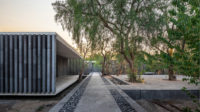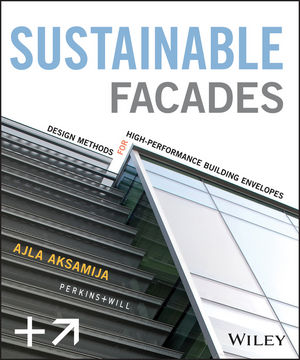Dallas City Performance Hall




















SOM
Dallas
The dallas Arts District—a 68-acre area in the city's downtown masterplanned by Sasaki Associates—is dense with architectural gems devoted to the visual and performing arts. Its anchor is Edward Larrabee Barnes's Dallas Museum of Art, completed in 1984. Over the next 20 years, up went I.M. Pei's Symphony Center (1989), Renzo Piano's Nasher Sculpture Center (2003), and Allied Works' expansion of the Booker T. Washington High School for the Performing and Visual Arts (2008), among other new buildings and renovations. A Foster + Partners performing arts center followed in 2009, as did the REX/OMA Wyly Theatre. James Burnett's Klyde Warren Park was completed in 2012, along with Morphosis's Perot Museum of Nature and Science.
What was missing from this mix was a place for smaller, local performing arts groups—everything from the Dallas Black Dance Theatre to the Dallas Asian American Youth Orchestra and the Uptown Players, a community theater company. So the city put out a $38.2 million bond in 2006 for the construction of just such a home, and commissioned Skidmore, Owings & Merrill (SOM) to design it. “It had been a long-irritating thing that all of the well-funded groups were getting buildings, but no one was addressing the nonprofit neighborhood groups,” says Nancy Abshire, project manager, from SOM's Chicago office. “Dallas felt it had to incorporate them.”
Before proposing any schemes, SOM interviewed 70 local groups, toured the inadequate spaces where they were performing (church basements and abandoned bathhouses), and studied a complicated matrix of data on ticket sales and performance numbers. “The city said that we should listen and give the organizations what they are asking for,” says Abshire. “The scope exceeded the bond, because no one had talked to these groups before. When that was determined, we said let's build it in two phases.” In September 2012, the first phase of SOM's City Performance Hall was complete: a 59,000-square-foot poured-in-place concrete and steel rectangular volume in the northeast corner of the Arts District, adjacent to the Wyly and the performing arts high school. Phase two—a pair of black-box theaters—will be added at a later date, yet to be determined.
The performance hall contains a 750-seat two-level theater, a proscenium stage with an 80-foot-high fly tower, an orchestra pit, offices, and a loading dock. The multilevel lobby serves as another adaptable performance and event space, and is on elegant display from the street, thanks to a completely transparent northwest facade. The board-formed concrete walls of the theater work well acoustically and complement the hall's muted palette. The concert shell is lined with movable oak-paneled walls and tilt-and-fly ceiling panels that can accommodate various types and sizes of performances, addressing a key challenge.
Each of these aesthetic decisions has a distinct purpose, like the tapestries of double-layer wool serge that hang down the theater walls and absorb sound. Instead of a fabric stage curtain, SOM installed a programmable LED screen—yet another space for artists to curate.
The flexible rental hall has surpassed expectations. “It's the hottest ticket in town,” says Abshire. Before it opened, the city projected that it would host 100 events and hoped to attract 36,428 patrons. But in its inaugural 2012–13 season, 162 events were attended by 51,388 people. For the 2013–14 season, 184 events are scheduled, with bookings already made for 2015. Russell Dyer, the performance hall's general manager, calls the building a “workhorse theater” and says its beauty is in its functional simplicity. “Yet it's state-of-the-art,” he adds. Dyer says that SOM truly listened to—rather than just paid lip service to—local groups' needs. An example he likes to cite is the fact that the loading dock floor is level with the stage floor, which is level with the lobby floor, making it easy for groups to move in and out. SOM also built in ample storage space, so that the hall could hold onto chairs, platforms, music stands, and other things that need to be within reach. The hall is user-friendly, says Dyer, and able to accommodate groups with a lot of production experience as well as those with none. One of the highest compliments the building has been paid, he says, is that the Dallas Symphony Orchestra has been eager to book it, even though its home is the acoustically marvelous Morton H. Meyerson Symphony Center nearby.
For SOM, known for supertall towers and feats of engineering, a project like the Dallas City Performance Hall might seem to be a diversion, but partner Jeff McCarthy says that's exactly why it was an important project for the firm, which had a good relationship with the city after completing an expansion of the convention center in 2002: “I think the things that truly made it interesting were the budget, the profile of performances, and the mission—that it would be an inspiring venue for emerging artists who might be stepping on a stage of this sort for the first time.”
Architect:
Skidmore, Owings & Merrill LLP
224 South Michigan Avenue, Suite 1000
Chicago, IL 60604
Tel: (312) 554 – 9090
Fax: (312) 360 - 4545
Size: 59,000 square feet
Total project cost: $40.8 million
Completion Date: August 2012
PeopleClient: City of Dallas, Public Works Dept, Thomas Wurtz, AIA, Project Manager Owner: City of Dallas Office of Cultural Affairs, Russell Dyer, General Manager Design Architect / Engineer: Personnel in design architect's firm who should receive special credit: Architect of Record: Structural Engineer of Record: Mechanical Engineer of Record: Civil Engineer of Record: Consultant(s): Architectural Lighting Design Acoustics & Audio Visual Environmental Graphics & Wayfinding Design Sustainability Interior Furnishings, Fixtures & Equipment Fire Protection + Building Code General Contractor: Photographer: |
ProductsStructural system Exterior cladding Metal Panels: Zinc Composite Metal, Manufacturer: Alcoa-Alucobond Metal/glass curtain wall: Steel Glass Curtain Wall, Manufacturer: Technical Glass Products (TGP) Rainscreen: Zinc Composite Metal Rainscreen Panel, Manufacturer: Allpolic, Now Specialties Precast concrete: Moisture barrier: Blueskin VP Air Barrier Membrane, Manufacturer: Henry Company Roofing Metal: Zinc Coated Aluminum Standing Seam Metal Roof, Manufacturer: Kalzip Windows Glazing Skylights: Manufacturer: Oldcastle Doors Metal doors: Interior doors (not at curtain walls or entry into auditorium), Manufacturer: Ceco Special doors: Acoustic Sound and Light Lock doors, Manufacturer: VT & Rockwood, Dorma Closers, Rixson Assa Abloy Pivots Upswinging doors, other: Loading Dock coiling door – Manufacturer: Cornell Hardware Closers: Dorma Exit devices: Dorma Pulls: Trimco Interior finishes Acoustic Plaster: Manufacturer: Baswaphon Suspension grid: Linear Wood Ceiling in Lobby, Manufacturer: Architectural Components Group, Inc. (ACG) Demountable partitions: Metal Toilet Partitions, Manufacturer: Accurate Partitions Cabinetwork and custom woodwork: Wood handrails – Installer: Facility Construction Services Paints and stains: Interior Paint, Manufacturer: PPG Wall coverings: Fabric Wrapped Wall Panels at door ways into audience chamber, Manufacturer: Wall Technologys; Metal Faced Acoustical Panels, Manufacturer: Custom Architectural Design (CMA) Paneling: Rift Sawn White Oak Panels at Audience Chamber, Manufacturer: Facility Construction Services Solid surfacing: Countertops, Manufacturer: Corian Special surfacing: Stage Flooring System Manufacturer: Connor Sports Flooring Floor and wall tile (cite where used): Pavers in Garden Area, Manufacturer: Hanover pedestal pavers, Toilet Room Tile, Manufacturer: Royal Mosa Resilient flooring: Underlayment manufacturer: QT (Encore); Cat Walks rubber pads, Manufacturer: Eco Nights; Sheet Vinyl Floors, Manufacturer: Melodia Carpet: Tile Carpeting, Manufacturer: Color Choice Special interior finishes unique to this project: Concert Enclosure System/Towers, Manufacturer: Wenger Corporation Metal Ceilings: Aluminum Faced Plymetal Panels: Alpolic Wood flooring: Rift Sawn + Quarter Sawn White Oak flooring, Manufacturer: Woodwright Hardwood Floor Company, Inc. Furnishings Reception furniture: Bernhardt, Herman Miller & Davis Furniture Fixed seating: Theater seating: Manufacturer: Ducharme Seating; Vinyl Upholstery: Kravit Chairs: Davis Furniture & Bernhardt Tables: Davis Furniture Other furniture: Benches: Davis Furniture; Lectern: Chancellor Lighting Downlights: We-ef, Kurt Versen Dimming System or other lighting controls: Dimming + Lighting Control System, Manufacturer:Electronic Theater Controls (ETC) Other: Color Kinetics, Times Square Conveyance Accessibility provision (lifts, ramping, etc.): Wheel chair lifts, Manufacturer: Garaventa Lift Plumbing
There are two main public restrooms on the ground floor and eight individual family restrooms on the 2nd floor. Low flow plumbing fixtures were installed (by Zurn, Sloan). All faucets are solar motion controlled. All lavatories and urinals low voltage auto flush. Energy Outdoor Ventilation Air: Other unique products that contribute to sustainability:
Add any additional building components or special equipment that made a significant contribution to this project: ACOUSTICS:
THEATRE PRODUCTS
“In lieu of a traditional grand curtain, the stage has a unique LED “main curtain.” This feature consists of an open mesh with LED nodes on 8-inch centers vertically and horizontally, with a separate black traveler behind. Each component is on its own rigging line-set and can be operated separately. Schuler Shook and SOM envisioned this main curtain as a canvas for commissioned art by local Dallas artists. Schuler Shook researched the technology and specified the curtain construction and control system. The LED color-changing nodes are controlled through an ETC Mosaic system, which can accept any electronic video file and re-create it on the curtain. The curtain becomes a palette for electronic kinetic art.”
|















